They talk funny in South Carolina, real strong accents and we are greeted with “ow y’all doin?” It is here that we enter the southeastern USA, where wars were fought, slaves were bought and sold and many traditions have survived the ravages of time.
Charleston is located in South Carolina and is one of the most beautiful cities in the south. It oozes charm, with its well-restored antebellum mansions and gardens, large oak trees with hanging Spanish moss lining the streets, and horses plodding along pulling carriages laden with tourists all clicking away on their cameras.
Enlarge

Adventurouspirits
Charleston was named, “The Best Mannered City in America” 11 years in a row. We wander down to the Battery in awe of the beautiful mansions dating from the era of the slave trade and the associated booming economy of tobacco, rice and indigo plantations. The Charleston slave mart was once one of the busiest in the American colonies and it is estimated that almost 80% of slaves imported into the colonies came through Charleston. Today Charleston is a busy port, also depending heavily on tourism.
Enlarge

Adventurouspirits
We booked into the campsite at James Island Park and I went off for a walk. I met a couple with 2 dogs and they invited us to join them in their truck to go and see the Holiday Festival lights with them that evening, which we did and the lights were fabulous.
The Christmas light show has over 500,000 lights with over 600 individual displays along a 3 miles enchanting drive. It was not yet open to the public, but the campsite is located in the park and they were doing the testing of the lights that evening. We had the lights to ourselves and they were truly spectacular. The lightshow is listed as one of the top 10 Christmas lights shows in the USA.
To make our evening even more special we were introduced to She Crab soup a Charlestown speciality. The soup is a cross between a bisque and a chowder and is considered the city’s signature dish. It is made with several ingredients including cream, blue crab, crab roe and sherry and it is quite divine.
Enlarge

Adventurouspirits
We have a deep interest in the slave trade as we had visited several slave locations in West Africa. We had witness the conditions the slaves were subjected to whilst waiting to be shipped to the Americas and were keen to see where they had arrived and what had happened to those who had survived voyage.
Enlarge

Adventurouspirits
We booked a “Black History Tour” with Al Miller and headed off to explore the area and learn about the history of the blacks in the area. It was fascinating and Al was a fabulous guide. We listened to amazing stories of the Gullah culture, civil war, slavery, free blacks and visited many interesting places.
Enlarge
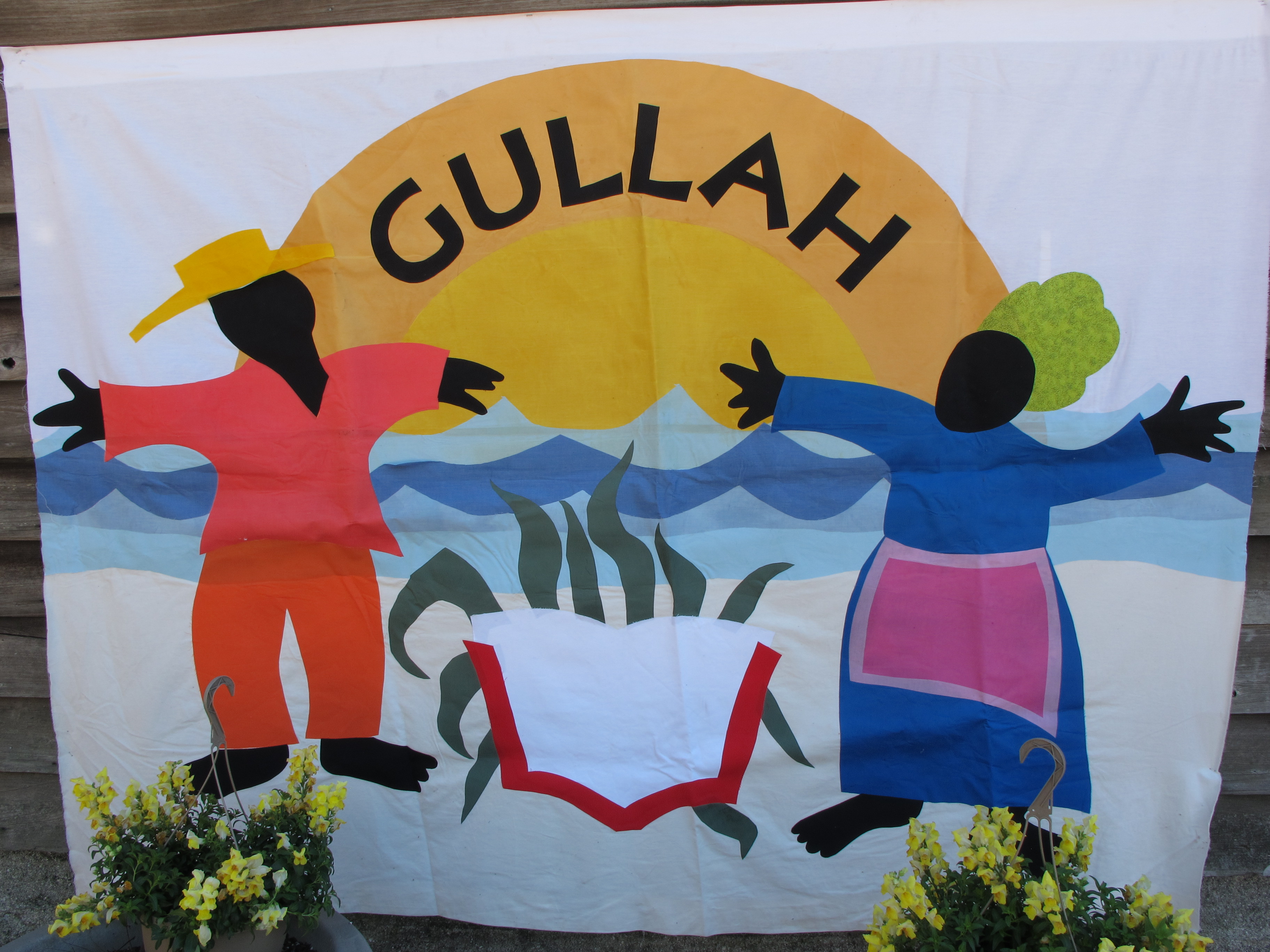
Adventurouspirits
We learnt that the opera, “Porgy and Bess” by George Gershwin was based on a novel, by DuBose Heyward. The novel was based on a real life character Samuel “Goats” Small. Sammy Small was a crippled foul smelling fishmonger with criminal record who drove a goat drawn cart and known to frequent Cabbage row, a crowded tenement with residents selling products on the street. As a child, he had polio and was often seen on a cart being pulled by a goat hence his nickname, “Goats.” The story is about his attempt to rescue Bess from her violent and possessive lover and the “Sportin’ Life” the drug dealer. A fascinating fact is that it took until 1970 before a mixed audience of blacks and whites in Charleston watched the opera together. Times they are a changing.
Enlarge
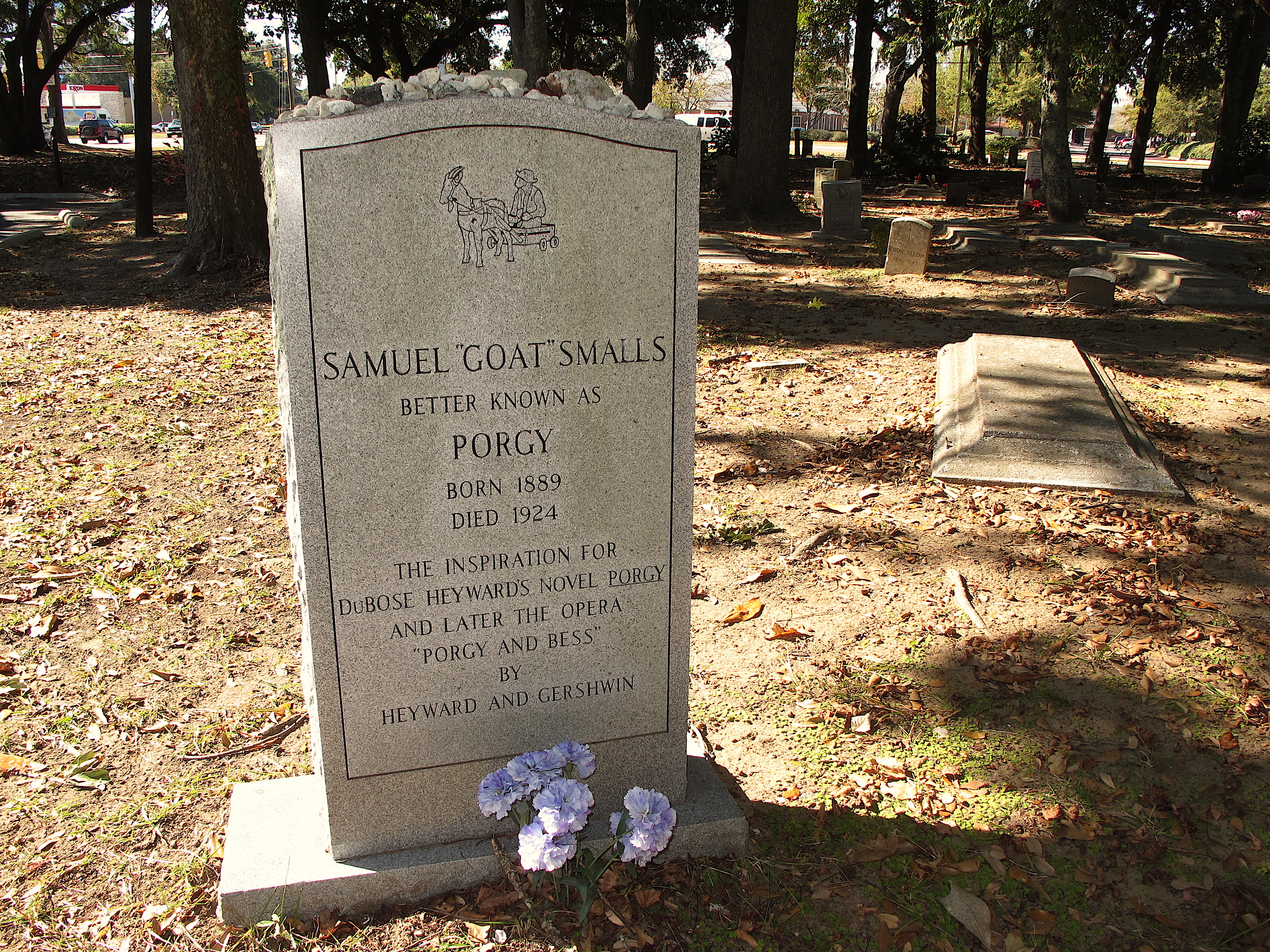
Adventurouspirits
We then headed out to John Island to see the famous Angel oak tree, which is estimated to be over 1,500 years old. It is spread over 17,000 square feet with branches hanging down to the ground. The locals say it grew like this, as it was an angry tree because of the hangings, which occurred here especially of slaves and now “hainks” or evil spirits or ghosts live in the tree.
The locals used to meet here until the 1980’s when the city took over the tree to ensure its survival and in fact, when we were visiting, arbour specialists were up in the tree wiring up some branches. It is amazing to think the tree was here before Christopher Columbus arrived, imagine the history this tree could tell us.
Enlarge

Angle Oak
We headed back to Charleston passing a mansion with its beautiful oak lined drive way and close by it slave quarters that still stand today.
Enlarge

Adventurouspirits
Across from Charleston lies Sullivan Island where the slaves were originally landed. They were housed in “pest houses” and kept in quarantine for 10 days before going to the mainland to be sold. As we stood at the Battery looking across to the Island, I noticed a memorial to the 26 victims of hurricane Hugo that struck Charleston 21 September 1989.
Enlarge

Adventurouspirits
The Stono Rebellion the largest slave uprising in early America (Sept 9 1739) commenced in South Carolina. The slave were hoping to reach St Augustine in Florida as they believed the Spanish were offering freedom and land to any fugitive. The band of slaves gathered together raided a firearms shop and headed south killing more than 20 whites as they went, other slaves joined the rebellion until there were about 60, but they were pursued by armed whites and by dusk most were dead and those that had escaped were eventually captured and executed. In response to this rebellion Carolina legislation passed the Negro Act of 1740, which restricted slave assembly, education and movement, it also established penalties against slave owner’s harsh treatment of slaves.
Enlarge

Adventurouspirits
John Calhoun was the seventh VP of America, a leading Southern politician from South Carolina who built his reputation on the approval of slavery. Widely accepted in the south and rejected in the North at the time he was not a man admired by all. He was an outspoken proponent of the institution of slavery, which, he famously defended as a “positive good” rather than a “necessary evil.” A statue to John Calhoun in the park had to be raised high as people who opposed his philosophy were spitting and pissing on him. Now days only the pigeons get to piss on his head.
Enlarge

Adventurouspirits
We headed up the oak tree-lined driveway past little marshes towards the Drayton brick Georgian Mansion built in 1742. Located on the Ashley River it used to be a rice plantation making the Drayton family very wealthy. The African slaves working on this plantation brought with them the skill and knowledge necessary for rice cultivation. It is the only plantation house to survive the Revolutionary and Civil Wars intact.
Enlarge
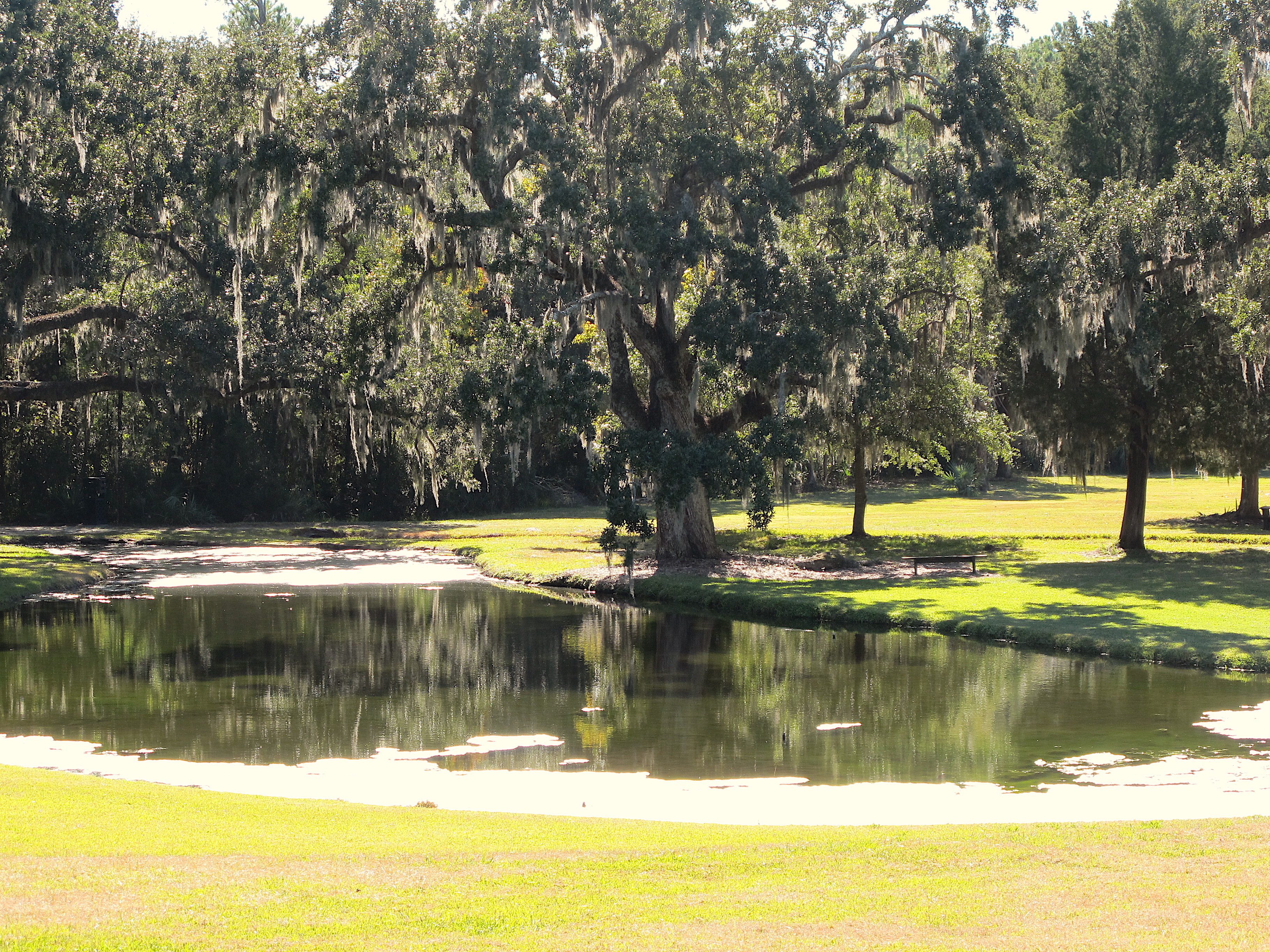
Adventurouspirits
Enlarge

Adventurouspirits
It stands empty of all now except for ghosts of the past and walls with a million secrets. Ornate hand carved and cast plaster ceilings, hand carved decorative moldings around several fireplaces are all that remain, and attempts are being made to preserve them from further deterioration. A sweeping stairway leads upstairs and hidden from view of the guests, the spiral staircase used by the slaves. Our guide took us through the house describing the architecture and the Drayton family characters. We try to understand the men behind the plantations and the slave owners but it is now time for us to move on and meet the descendants of slavery and learn their stories.
Enlarge

Adventurouspirits
We decided to spend Remembrance Day amongst USA veterans on board the USS Yorktown aircraft carrier, the flagship of Patriots Point Naval and Maritime Museum.
The day began with dolphins swimming alongside the ferry as we headed towards Patriots Point, the Yorktown in view looming large in the distance all 888 feet long and 30,000+ tons.
Enlarge

Adventurouspirits
The USS Yorktown was the USA’s 10th aircraft carrier, first commissioned in 1943 and she joined the Pacific offensive that led to the end of WW11 in 1945. She is nicknamed the “Fighting Lady” from the title of the Academy Award winning documentary filmed aboard her during her first years of service. She served first as an attack carrier and later was redesigned (1957) as an antisubmarine aircraft carrier. She served in several wars but her last duty was the recovery of the Apollo 8 astronauts from the Pacific who had descended back to earth in their space capsule in 1968. The first manned spacecraft to circle the moon. She was decommissioned in 1970 and now is permanently moored in Charleston Harbour.
Enlarge

Adventurouspirits
We arrived at the Yorktown a few minutes before 11:00am and stood in silence for a minute with the veterans before beginning to explore the more than 250,000 square feet of her and chatting to some veterans.
Enlarge
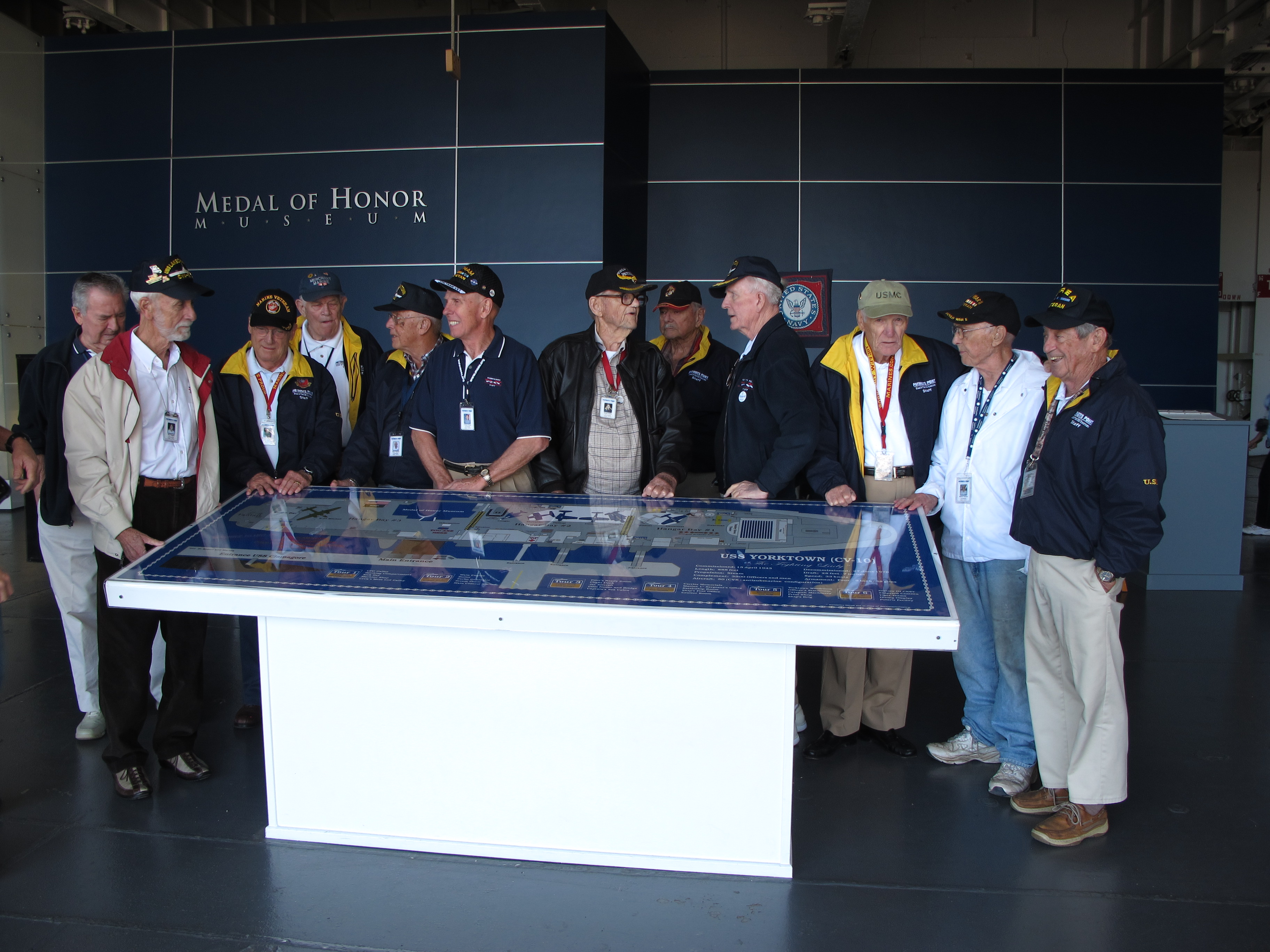
Adventurouspirits
Standing on the flight deck and bridge amongst the planes and helicopters one can imagine the noise, the smells and the activity during the battles of WW11, Korea, Vietnam and the Gulf War. I cannot imagine the feeling of a pilot trying to land or take off on the deck, which is bobbing up and down in the sea and especially during combat; it must have been a heart pounding experience even for the toughest of men. Chatting to veterans of several wars hearing their stories made me thankful I have never had to face a war. The Medal of Honour Museum on board the Yorktown has videos of men talking about their experiences, bringing to life once again the stories of men who had received the USA’s highest honour- The Congressional Medal of Honour.
Enlarge
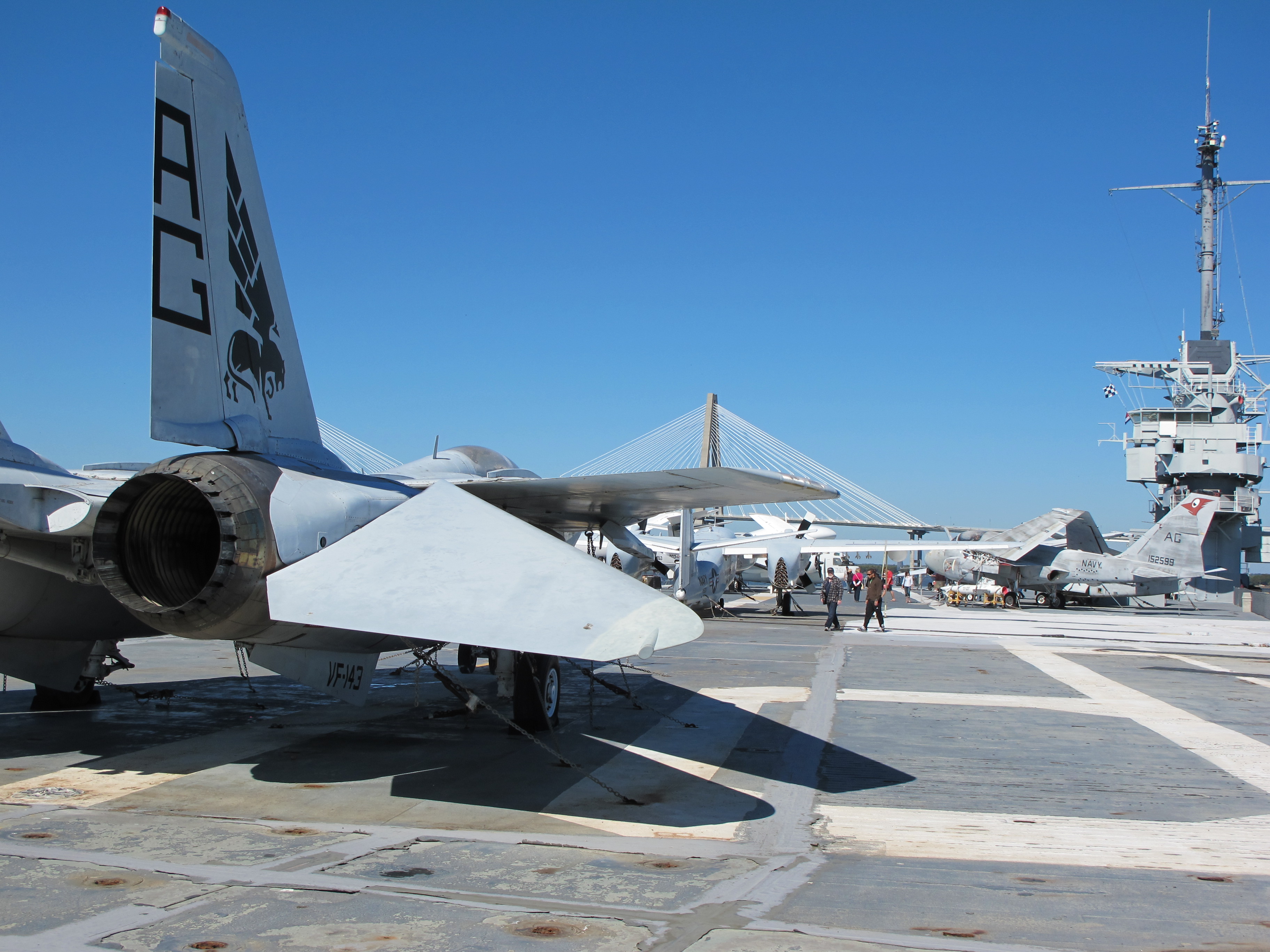
Adventurouspirits
Alongside the Yorktown is the submarine Clamagore that operated in the Mediterranean and Atlantic towards the end of WW11 and patrolled the Cuban waters during the tense period of USA/Soviet relations in 1962. Climbing down into the submarine I quickly realized that living on board is not for claustrophobics, or those who cannot live in very close quarters with other people. The spaces are tiny and Tom had to squeeze himself through the watertight doorways between each compartment. He managed well he has had lots of practice squeezing himself past me in the camper.
Enlarge

Adventurouspirits
Enlarge

Adventurouspirits
It was time to leave Charlestown but not before, we visited some plantations so the next day we packed up and headed for the Ashley River Plantations. Then we are off to experience the annual Gullah Heritage Festival in the heart of Gullah communities on St Helena Island.
Enlarge

Adventurouspirits
We head for St Helena Island, considered the heart of Gullah, to attend the annual Gullah Heritage Festival and learn more about the Gullah (Geechee.)
Enlarge

Adventurouspirits
We arrived in the mass of people all heading towards Penn Center on St Helena heading towards the annual Gullah Heritage Festival. The crowd was lively and noisy, we seemed to be the only white faces in the crowd and it felt great. I felt like I was back in Africa, drums beating, children squealing with delight and adults teasing each other and laughing. The soul of Africa was alive in the crowd; Gullah culture, language, food, art, music and celebrations were all introduced to us.Gullah, the “language that time forgot” is a language and a way of life passed on from early slaves who worked on the mainland plantations. Kidnapped from their home countries and unable to communicate with each other or the whites they developed a unique language based on the various languages spoken in West Africa. The isolation experienced by slaves on the coastal islands of South Carolina facilitated the preservations of many African traditions, customs, music and art. The Gullah communities still speak Gullah and maintain many of their ancestor’s ways of life.
We had the opportunity to chat with many folks First time writer Mildred Clover who wrote a children’s book about her dog Buddy and the events he endured during Hurricane Katrina. “Buddy Heads for Home.”
Bruce Ingram and his passion for folk art and historical renditions that tell stories that inspire him to create uniquely southern art pieces. We could have listened to him for hours he was so entertaining and with such wonderful stories to share. His art was moving and he explained each piece to us.
Enlarge

Adventurouspirits
Enlarge

Adventurouspirits
Mary sat in the shade of a tree weaving a sweet grass basket. She told me that it was an African tradition and when I told her, I was from Africa she was intrigued and asked me if they really made baskets like she was making in Africa. It was so ironic that a white person from Africa was telling the black from America all about Africa.
Enlarge

Adventurouspirits
Joe told us about his search for his roots and the DNA testing he had done. The results indicate he comes from Benin and Cameroon regions of Africa. He was fascinated when we told him we had visited those countries. The need to know and understand his roots was deep. He said that he was going to have further DNA testing done.
Enlarge
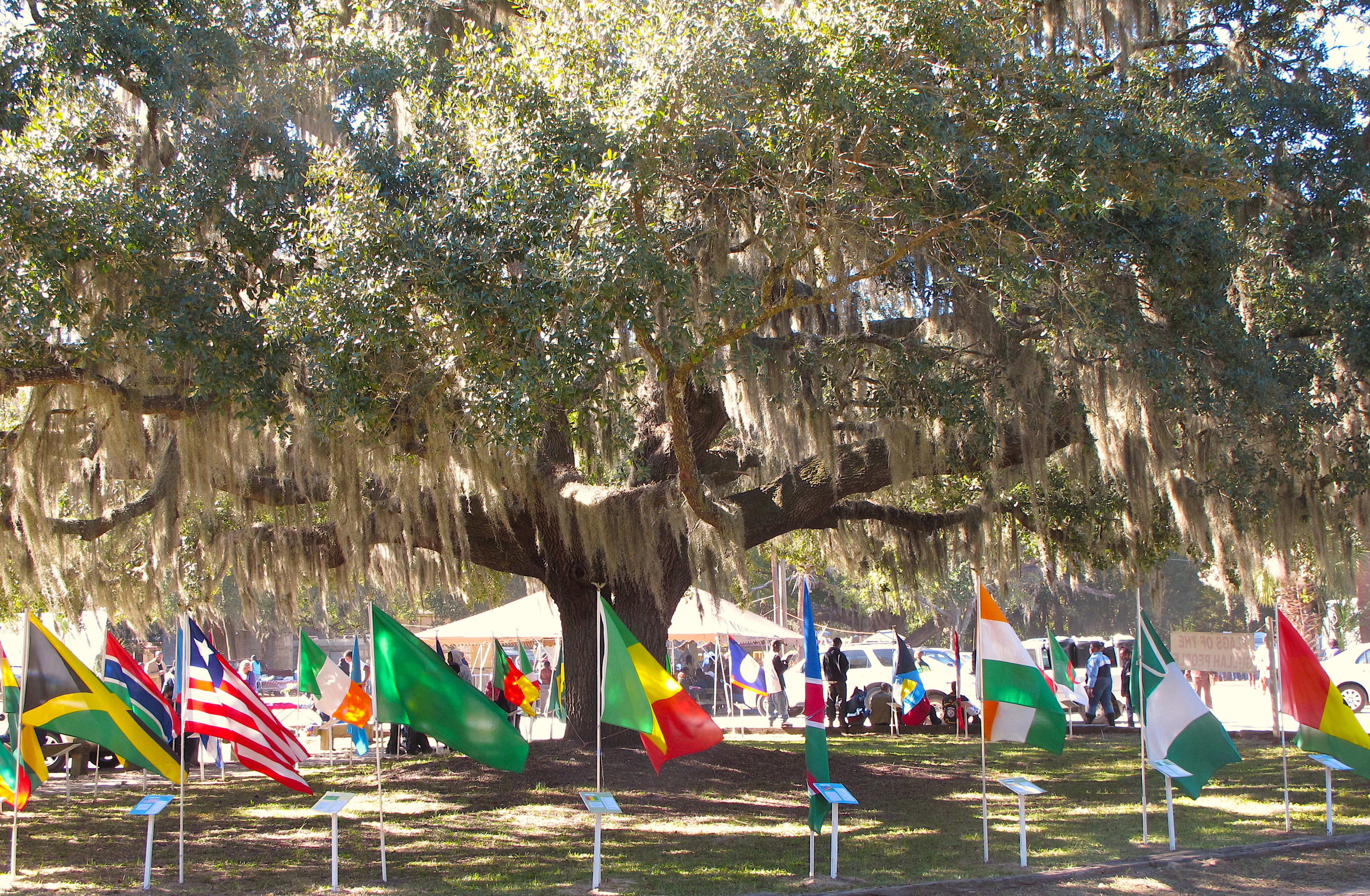
Adventurouspirits
“To know the history of our past helps us to better understand and appreciate who we are.” He said. I wondered how I would feel if I had no idea where I came from in the world.
Enlarge

Adventurouspirits
We sat under the sun and listened to fabulous African American musicians. The sound of the drums and the rhythm of the dancers transported me back to Africa, and longed to be there again. Children and the audience jumped up on the stage in their exuberance and the master of ceremonies, “Auntie Pearlie Sue” was hilarious.
Enlarge

Adventurouspirits
Enlarge

Adventurouspirits
Finally, it was time to taste the cooking. Everything is fried!!, Fried gator (tastes like chicken), fried shrimps, fried fish, fried pickles, fried crabs, Gullah rice and sweet tea. Now that is not African cooking but tasty all the same.
Enlarge

Adventurouspirits
Enlarge

Adventurouspirits
The day was special and the people we met ever more special and we understand just a little more about what happened to the slaves who arrived in America from Africa. Listen to the music and see the Gullah Festival after touring the plantation
We arrived at Savannah a city in Georgia and set off to explore the historical district. Certainly not as “well groomed” as Charleston and it was busier and more lively. We enjoyed watching a wedding in John Wesley’s square, wandered along the converted cotton warehouses along the Savannah River, where we found bars, restaurants and touristy shops. There was a musician playing a trumpet, artists selling their art, small groups in prayer, tourists with cameras and children eating candy. It was time however for us to head for a campsite for the night so we headed south to a beautiful location on the lake. It was a special day with a stunning ending of birds settling down for the night.
Enlarge

Adventurouspirits
Enlarge

Adventurouspirits

Love the dragon lights!!
Margaret they were spectacular I loved them the most and it was moving so the dragon was blowing fire
I love southern plantation architecture, those oak trees are unreal so much character.
You are right about the trees they are magnificent especially love the moss that hangs from them when the sun shines through that them